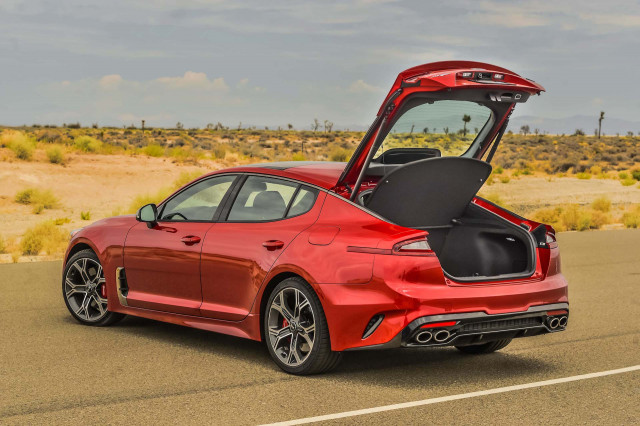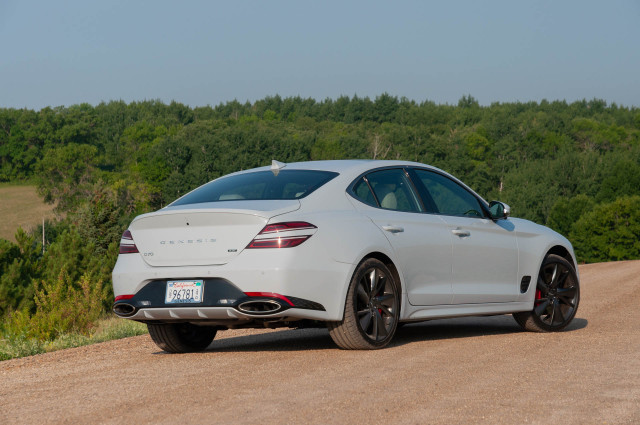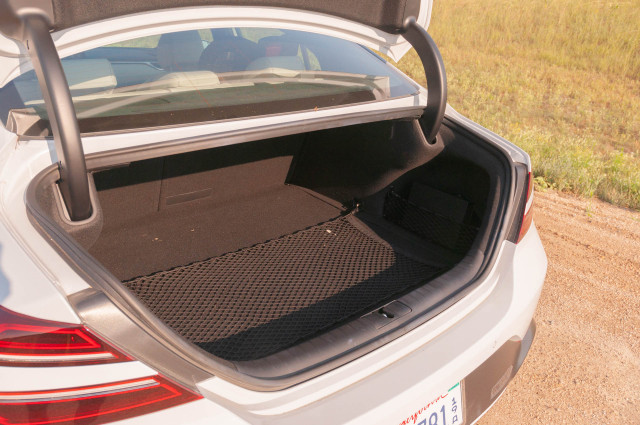2022 Kia Stinger vs 2022 Genesis G70: Compare Cars
Two of the more compelling sedans performing under the radar this year continue to be the Kia Stinger and Genesis G70. The related rear-wheel-drive cars offer unassuming but impressive performance at a relative value, and with a warranty and standard feature set that’s far better than other premium or entry-level luxury vehicles.
Crafted by famed German auto designer Peter Schreyer, the two models share chassis, powertrains, and other mechanicals. For 2022, after about five years on the market, the brands disentangle the sedans’ shared DNA to make them each more representative of Kia and Genesis, who cultivate distinct identities under their parent Hyundai Motor Group. The refreshed Stinger sports a more powerful base engine to complement its fastback looks, and the refreshed 2022 Genesis G70 merges into the ascending design language of the Genesis luxury brand.
From the outside, there’s no mistaking the two. The Stinger remains a five-door fastback with full access to the 60/40-split rear seats. With a rounded rear, its curving roofline sweeps right into the tail, like many Audi and Porsche sedans. While they both have long noses and short overhangs befitting their sport sedan roots, the G70 is a more traditional sedan with a trunk. Its large crest-shaped grille and slim LED headlights split by daytime running lights carry the Genesis brand, and it’s more honest in how it favors side intakes instead of the faux hood intakes on the Stinger.
All the ventilation is necessary for the top engine offered in both models, an exquisite 365-hp, 3.3-liter twin-turbo V-6. Design favors the G70 in the sprint to 60 mph, however, which has an official time of 4.5 seconds compared to 4.7 seconds for the Kia Stinger, which can weigh about 150 lb more. A quick 8-speed dual-clutch automatic directs the action to the rear wheels, though all-wheel drive is available in either model for $2,200 more in the Kia, or $2,100 more in the Genesis.

2021 Kia Stinger

2020 Kia Stinger

2022 Genesis G70

2022 Genesis G70
All the ventilation is necessary for the top engine offered in both models, an exquisite 365-hp, 3.3-liter twin-turbo V-6. Design favors the G70 in the sprint to 60 mph, however, which has an official time of 4.5 seconds compared to 4.7 seconds for the Kia Stinger, which can weigh about 150 lb more. A quick 8-speed dual-clutch automatic directs the action to the rear wheels, though all-wheel drive is available in either model for $2,200 more in the Kia, or $2,100 more in the Genesis.
The base models invert the power hierarchy this year. Kia usurps the G70’s throne with a new 300-hp 2.5-liter turbo-4, which, at 5.2 seconds, is at least a full second quicker to 60 mph than the G70’s 252-hp 2.0-liter turbo-4. Yet the 8-speed automatic lacks the dual-clutch unit of the top model, and it can be slower to interpret inputs from the driver, especially when going hard from brake to gas. Crisp steering acquits both cars, but the four-wheel independent suspension is tuned firmer on the more fun-to-drive G70. It might ride too firm for drivers keen on touring cars.
The difference in cost between the base turbo-4s is about $1,500: The 2022 Stinger GT-Line RWD costs $36,290, including destination, and the 2022 G70 2.0T RWD costs $37,775. At the opposite end of the spectrum, the twin-turbo V-6 that we’d recommend tops out at $54,750 for the G70 Launch Edition AWD, which is only $1,000 more than the top Stinger GT2 AWD.
It would seem the Stinger is a better relative value but the G70 is nicer inside, and an unmistakable grade up from premium to luxury.
All but the base G70 comes swathed in leather upholstery and with heated power front seats and bolsters that hug your sides in sport mode. The dash cants toward the driver and it’s topped with a 10.3-inch touchscreen with smartphone compatibility. The rich leather and aluminum brightwork with knurled dials and simple buttons makes it a warm driver-friendly cabin.

2022 Genesis G70

2022 Genesis G70

2022 Kia Stinger

2020 Kia Stinger
The Stinger gets the same treatment but with standard leather upholstery that pops in red. They both get excellent standard driver-assist features, including automatic emergency braking, active lane control, blind-spot monitors, adaptive cruise control, and rear parking sensors, and their 5-year/60,000-mile warranty with three years of free maintenance shames rivals.
Despite the similarities, the G70 is a nicer place to be, unless you’re a rear-seat passenger. Shorter than the Stinger by half a foot, the G70 has 34.8 inches of rear leg room versus the 36.4 inches in the Stinger, and you feel it; it’s also not as wide across. The bigger difference comes behind the rear seats. The Stinger’s hatch allows 23.2 cubic feet of space, and is big enough to fit two golf bags diagonally. The seats fold too, for even more flexibility. The G70’s trunk holds only 10.5 cubic feet of stuff; the seats also fold down but it lacks the vertical space of the Stinger.
Overall design may hold more sway over everyday practicality when it comes down to these two off-mainstream choices. Our TCC Rating system favors the 2022 Kia Stinger, with its 7.3 out of 10. But the 2022 Genesis G70’s 7.0 out of 10 lacks a safety rating from the NHTSA, so it’s a pretty even draw. For pure driving feel, we favor the G70. But not many other cars at this price have the visual appeal of the Stinger.


